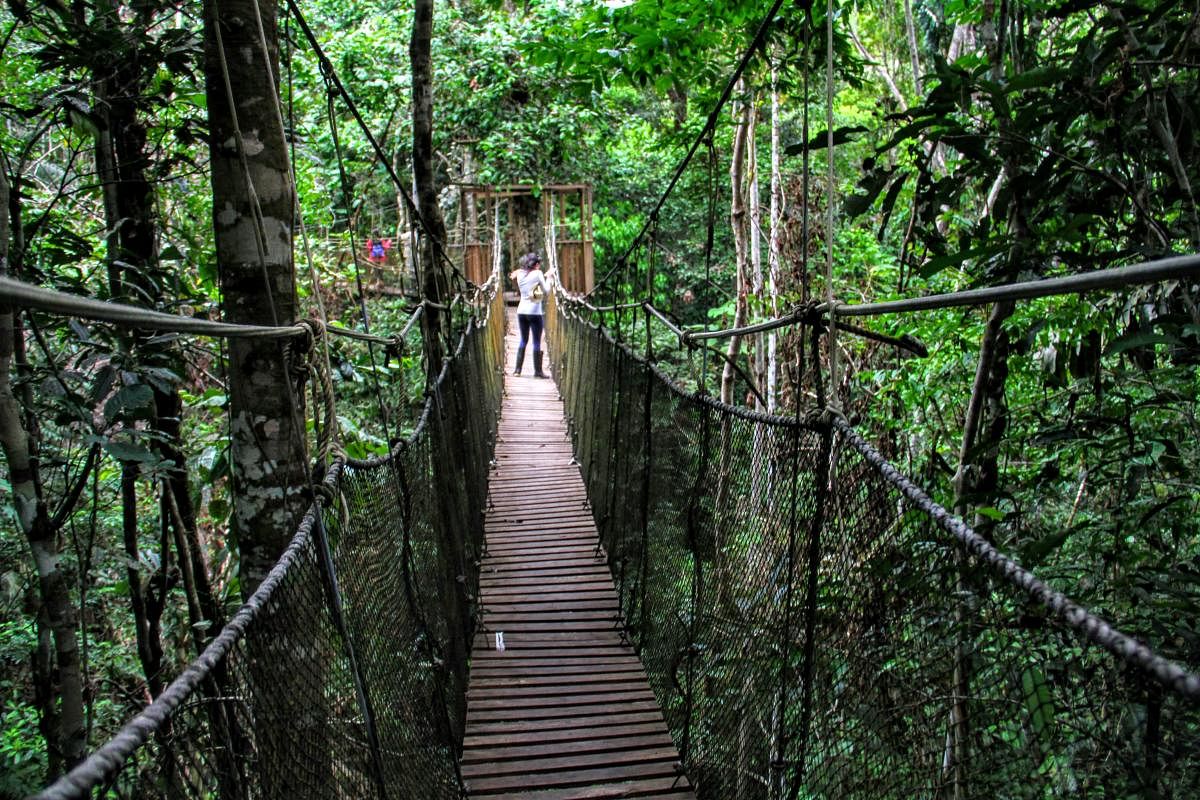
We are in the middle of the thick jungle, in a small clearing with a small hut. The pitter-patter of rain on the thatched roof is a soothing sound as we sit around on narrow wooden benches, and our guide, Juan Tejada, introduces the shaman, the local healer. She is dressed in a white peasant-style embroidered blouse with a flowing skirt, necklaces around her neck made from seeds, her loose hair framing her dark face, and glazed yet powerful eyes. Carola belongs to the local Amazonian Kukama tribe and has been practising shamanism for over 12 years.
Spottings
I’m cruising through the Peruvian Amazon on the luxury boat Zafiro. We are exploring the flooded woodlands of the Pacaya-Samiria Nature preserve, a five-million-acre area that’s part of the Amazon basin in northeastern Peru. Over the past few days, I have hiked through the rainforest in the company of a trained naturalist, spotting three-toed sloths on trees, tarantulas, and even a gargantuan anaconda coiled beside a waterbody; gone on a night cruise in the pouring rain to spot red-eyed caimans, and visited a local school.
I feel blessed to have an opportunity to explore the fragile ecosystem of the Amazon — this is where 20% of the earth’s oxygen is produced, and 90% of the plants used by natives have not been studied by scientists yet. “This forest may have the cure for many diseases that plague mankind,” says Juan.
berries and liquids, known to contain cure for many illnesses & disabilities.
One of the experiences that the cruise offers is a meeting with the local healer, called shaman, who enters a trance during a ritual and practises healing. “A shaman is a doctor, healer and therapist rolled into one, for the locals,” explains Juan. Carola explains in her native dialect that it’s not usual for the shaman to be a woman, but her grandfather had a vision about her powers and saw that she was born with a special gift, and therefore she was chosen at a young age to be the healer for her community.
Laid before her on a rickety wooden platform is a collection of leaves, bark, nuts, and berries, as well as liquids in battered plastic bottles. We learn that the Amazon rainforest is the greatest ‘green pharmacy’ in the world. Carola shows us the ‘cat’s claw’, a plant that derives its name from the hook-like thorns growing on the vine, the bark of a vine that relieves pain and inflammation, as well as enhances immunity. Another plant used is the Dragon’s blood trees. Tall with a white and grey bark, they are cut into with a machete to extract the resinous sap used by the natives for treating cuts, bites, burns, stings and wounds. The patchouli plant acts an insect repellent and cures a host of problems from baldness to cough!
Another controversial substance found in the forests is ayahuasca — a vine, which is used by shamans to induce an altered state of consciousness, during which they can look into the future and induce healing.
The word ‘ayahuasca’ comes from the Quechuan Indian words — ‘aya’ meaning spirit and ‘huasca’ meaning vine. Ayahuasca has become something of a controversy in recent years with many Westerners who want to rid themselves of problems like drug addiction or depression flocking to the Amazon. “Unless supervised by a genuine shaman, these experiences can be dangerous,” cautions Carola.
Cure all
Carola works with the communities of nine riverine villages. She explains that she ingests ayahuasca, the hallucinogenic brew, to get solutions and sort out family problems, predict harvests, cure ailments, and she tailors her ceremonies to suit the patient’s needs. We watch her as she demonstrates how the woody vine is chopped and added to the roots of wild garlic. “Those who take ayahuasca need to go on a diet – it can only be consumed in liquid form after a period of fasting and bodily cleansing, a strict diet without salt or sugar and refraining from sex,” explains Juan. Juan tells us about how he encountered the spirit of his grandmother during his first ayahuasca experience.
At the end of our session, Carola proceeds to chant and then lights a mapacho, a large cigarette made from native tobacco. She blows billows of thick, tangy Amazon tobacco smoke over herself and then exhales a full breath of smoke across our heads. This is to release all negative energy and protect us from disease and misfortune. Though it’s a far cry from our life back in the city where a trip to the doctor or self-prescribed allopathic drugs is done without much thought, I muse on the possibility of living closer to nature like Carola and the people of these forests.